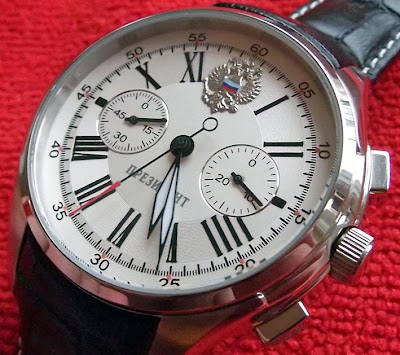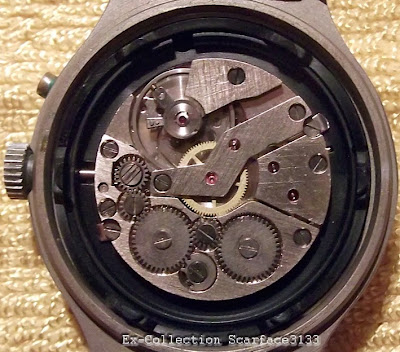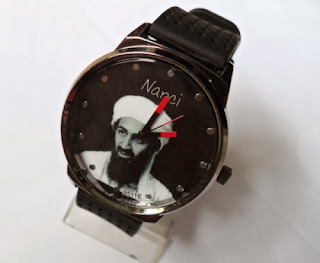Ex-Collection Scarface3133 (i.e. me) comes this watch -- the Poljot President 2940 by TD Poljot, one of the splinter companies of the former 1st Moscow Watch Factory. Pictures are clickable.
This watch is actually my newest major acquisition to date; I have had it since October 2013. It is an automatic chronograph, with a seconds sub-dial at 9 o'clock, a stopwatch central hand and a 30-minute counter at 3 o'clock. The watch is powered by the ST1940 Chinese automatic chronograph movement. In fact, I bought it specifically because of the movement; I just wanted to have this storied movement, derived as it is from the Venus 175, in a Russian watch and this Poljot President was the only watch currently available with the movement. Generally I am not much into government-themed watches as this watch (called President and featuring some state symbols of the Russian Federation both on the dial and the back) appears to be but I don't mind them too much.
The generic little booklet accompanying the watch is not very forthcoming about the origin of the movement, just states that it is an automatic chronograph and that it is made in Russia which may or may not be true, but the parts are certainly all made in China. But there is a clue in the numerical designation - 2940 because the ST1940 is also, I believe, sometimes known as TY2940.

Why do I think the movement is an ST1940 movement? Simply put, there is no other option really, considering it is a chronograph and an automatic chronograph at that and the layout of its subdials, so only the ST1940 fits the description. There are also other indications -- the way pushers operate -- much softer than on the Poljot 3133, especially the reset button, consistent with the chronograph being a column wheel type of chronograph (I believe), a different type from that of the Poljot 3133 or the Valjoux 7750 for that matter. Yet another tell-tale sign is the rater noisy and rough sounding Sea-Gull auto-wind rotor that is has.

The watch has a nice enough dial even though not everyone will appreciate the heavy-laden Russian-government symbolism on this watch. One theory is that these President watches were given away as gifts to those awarded state medals or other decorations or titles of honor or just given as tokens of respect. Something like that. On earlier President models, it said on the back not "President" like here but "From the President".
In the picture above is the case back with the Russian state emblem -- the double-headed (Byzantine) eagle, symbolizing Russia's origin as the successor of the East Roman (Byzantine) Empire by Royal marriage and via the Byzantine Empire the successor of Ancient Rome itself... or so the story goes. More about the double-headed eagle is
in this wikipedia entry.
I have to say I am not much into this type of strap though -- the way it attaches to the case -- there is probably a name for it but I don't know it (ETA Sept 25, 2014: I think it is known as LEONARDO / Curved Ends). I believe it will be difficult, or may be even impossible, to find a replacement strap or bracelet. The strap is a weak point -- it smells nasty like every Chinese leather (or "leather") strap seems to smell, even though the smell (I would call it "stink" if it were any stronger) is not as strong as in straps on some cheaper watches, care must have been taken to air it thoroughly, but it still is pretty unpleasant if you sniff at it closely (why would you do that?). What's more, it seems the glossy black finish was spray-painted on the strap as it has already started to come off revealing the dull bluish leather underneath (I still think it's leather and may even be genuine but you wouldn't say that on the evidence of the sense of smell alone).

The pushers of the watch are without bushings around them, they are very easy and comfortable to depress, very responsive. It is a thick(ish) watch but sits comfortably on the wrist because the strap forms a domed half-circle together with the case which is probably the only good thing about this way to attach the strap to the watch case but on the other hand you cannot lay this watch flat on the back.
The strap aside, I have been very pleased with this watch so far and think it is a good addition to my collection -- it brings in a new (to me) and great automatic chronograph movement (rare too as such automatic chronograph movements are) -- the ST1940, so what's not to like?
I measured its accuracy against reference time as I don't have a timograph or anything like that. I got +15 secs per 24 hours but it seems more accurate in day-to-day wear. The chronograph itself works flawlessly -- all functions -- start, stop and reset.
The white hands on a white dial may not be the best combination in terms of readability which is affected in certain lighting and from certain angles. There is some lume on the hands but it's not very effective.

















































